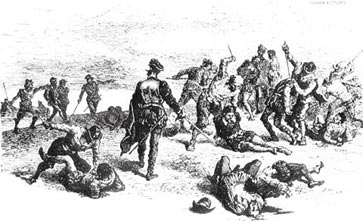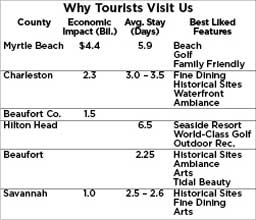Part 11: How Important is Santa Elena?
 Santa Elena is as important as Jamestown, Plymouth, or St. Augustine. It was the capital of Europe’s first colony in America. It was the capital of La Florida, a territory that ran from Canada to the Florida Keys and from the Atlantic to the Mississippi River.
Santa Elena is as important as Jamestown, Plymouth, or St. Augustine. It was the capital of Europe’s first colony in America. It was the capital of La Florida, a territory that ran from Canada to the Florida Keys and from the Atlantic to the Mississippi River.
Somehow, our children believe that America started from two independent acts: the settlement of Jamestown, and then Plymouth, Mass. But that is not what happened. The settlement of America started in three related waves.
First, the French tried, in 1562 and 1564, to establish settlements at Port Royal Sound (ie, Charlesfort) and Jacksonville (ie, Fort Caroline.) That triggered Spain to eradicate the French by 1565. They destroyed the French outposts and claimed La Florida for Spain by establishing settlements in Santa Elena and St. Augustine. Then, Spain was pushed out by a stronger England . . . but almost three hundred years later. In turn, the British settled in Jamestown, Plymouth, and Charleston.
Here is the problem. The textbooks do not accurately explain how America started. I stopped at Beaufort’s main downtown library. I informed the librarian that I would like to see history books that they would recommend for seventh or eighth graders. She went to the shelves and handed me three books. None of them even mentioned Santa Elena. One book was representative of all of the library’s history books for middle school children. It was called, “Everything You Need to Know About American History,” by Zeman and Kelly. Pages 10 and 11 inform our children how America was founded:
• 1492: Columbus arrived.
• 1513: Ponce de Leon claimed Florida. St. Augustine established in 1563
(Not true. It became a military garrison in 1565.)
• 1607: Jamestown established.
• 1620: Pilgrims land in Mass.
There is another reason why few people in America know about Santa Elena or the importance of the Spanish settlement of America. The existing historical settlements are tourist attractions. And they focus completely on themselves. Jamestown promotes the message “America Started Here.” Plymouth Rock touts, “The Pilgrims Landed Here.” St. Augustine sends the message, “We are America’s oldest continuous city.” Thus, the most important messages are lost – America was founded in three waves; first the French, then the Spanish, and then the English. These were not independent acts. They were interrelated acts. And without doubt, the Spanish movement, which started with Santa Elena and St. Augustine, was the most significant early phase in the settlement of America.
One of the most recognized scholars of early colonial Spanish history is Dr. Paul Hoffman of LSU. I asked Dr. Hoffman why the country’s text books start with the establishment of Jamestown rather than Santa Elena. His response was this: The English eventually won America from the Spanish. Thus, they wrote the first American history books. And they wrote the books from a political point of view like, ‘America started with Jamestown.’ But real history has America starting at St. Augustine and Santa Elena. St. Augustine was the first Spanish military garrison in America. Santa Elena was the first major settlement and colonial capital in America.
Spain’s medieval culture hampered its success in America. However, its very vision and intellectual curiosity triggered its willingness to explore unknown lands. Spain became the envy of Europe in the 16th century. It had the explorers and the entrepreneurs who had the vision. They were willing to lead. And the common Spaniard was willing to risk his or her life to do one thing – give his children an opportunity to have a better future.
Again, Larry Rowland is right. You cannot understand the early settlement of America unless you understand how England, France, and Spain related to each other in Europe. They were adversaries. They did not want the “other” country to have an advantage. Moreover, the Protestant Reformation had a huge impact on the settlement of America. France led the first planned landing on American shores because it was in the middle of a Protestant rebellion. Because of this, France’s middle class became energized. The country developed a sea commerce that it did not have before. This pushed the French king to support a plan to create a colony in Spain’s La Florida. Why? In part to give the French Huguenots (i.e. French Protestants) a home away from home where they could worship in peace.
That triggered Spain to react. In spite of being bankrupt, Spain uniquely funded the settlement of its claim for La Florida. What did Spain select as its first major settlement? Santa Elena on Port Royal Sound. Santa Elena also became Europe’s first colonial capital in America. Finally, England was watching this happen. They wanted their share of America. The Pilgrims were not happy with the Church of England that the Protestant Reformation, and King Henry VIII, had created. All of these landings on America were linked. And the Protestant Reformation had a big role in the motivation of each country to settle in what is now America.
Spain’s Santa Elena eventually became a success story by 1580. It was beginning to export hard woods, fruits, and vegetables. Santa Elena protected Spain’s gold fleet at one of its most vulnerable locations for 21 years. It helped the Catholic Church establish over fifty missions throughout the Southeast. It gave Europe more knowledge of coastal and inland America. And it helped the English by teaching them that you will only succeed if you make the Natives your friends and partners . . . not your serfs.







